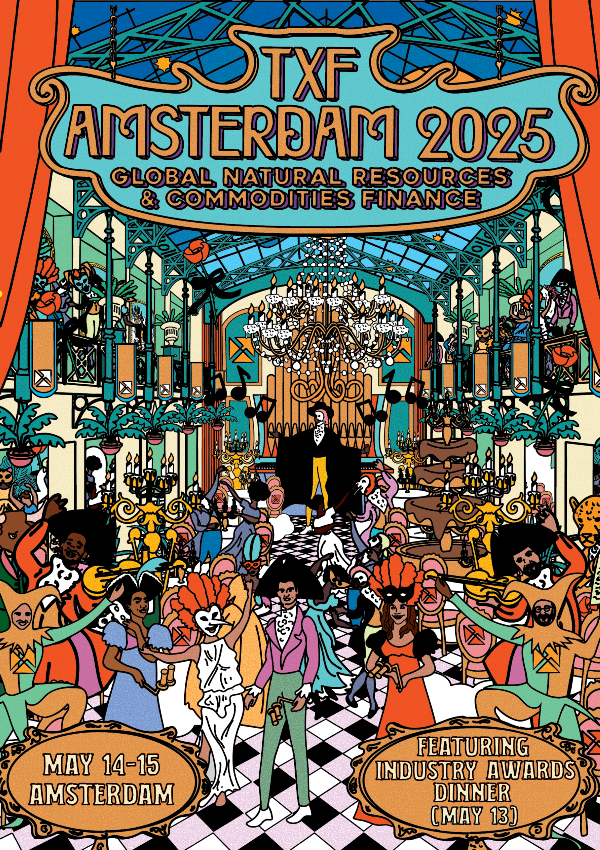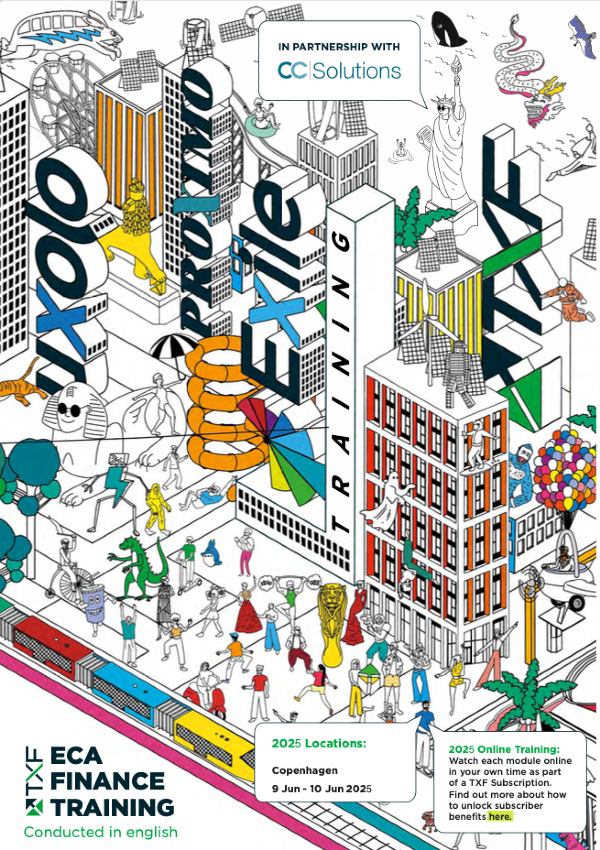ECAs up innovation and flexibility in Africa
Ahead of TXF Global in Madrid next week, Max Thompson takes a look at the increased innovation and flexibility ECAs are showing around the structure of export credits in Africa, particularly covering the 15% down payment financing traditionally needed for ECA-backed deals. And there is room for further development of the ECA product offering.

Africa has played host to a raft of innovative big-ticket financings in the ECA market this summer. The news bodes well for the wider export finance community given increased ECA collaboration and flexibility has long been touted as the key to taking a more holistic approach to large-scale project finance deals. And the funding mix backing African projects is becoming more diverse, too - in terms of bespoke structures and the blend of lenders on these deals.
The largest such scheme is Angola’s Luanda Bita Water Supply Guarantee Project, which is intended to improve access for over two million residents to potable water services in selected parts of south Luanda, and is backed by a $1.1 billion 15-year ECA/DFI-backed facility closed in June. The deal set a global record as the biggest World Bank guaranteed financing and makes a significant contribution towards UN Sustainable Development Goal (SDG) 6.
The project is funded by two loans: a $910 million facility supported by a World Bank IBRD guarantee (along with ATI guarantees); and a $165 tranche covered by the French ECA, Bpifrance. The deal is a relatively rare example of joint DFI and ECA financing support, a topic that should be high on the agenda at COP26 later this year as the world looks to progress the UN's SDGs.
This project is also a great example of an innovative blended finance solution using World Bank guarantees and ATI insurance that brought comfort to the financial markets and helped secure financing.
Given the size of investment required for the project and the level of uncovered risk, the government of Angola initiated discussions with ATI to explore potential additional credit insurance options. Working together with the private insurance market, ATI provided the lenders a second loss insurance above World Bank’s guarantee of up to $351 million to cover principal and interest, therefore, enabling the project to reach financial close. ATI’s cover will mitigate the risk of the government’s failure to make debt service payments under the loans for the project.
100% ECA cover: a lazy solution to residual risk?
Likewise this summer, Ghana’s MoF closed three landmark ECA-backed deals: a €280 million Euler Hermes-covered social loan to fund rehabilitation of the first section of the 773 km Eastern Corridor road; Deutsche and Investec arranged a €600 million EKN/ECIC-backed financing for a railway project; and a five-year €78 million (about £71 million) UK Export Finance-backed financing deal for a project to design, construct, and equip the new Eastern Regional Hospital.
The private insurance market has not shown the appetite to absorb the residual risk on ECA-backed financings in Africa as it did pre-pandemic, although there was already a perceived gap before the Covid crisis. When the pandemic hit and the private insurance market dried up, importers and project sponsors were calling institutions like Africa Exim-Import Bank and AfDB for cover on the residual risk on ECA-backed deals - but to no avail.
Discussions around ECAs having more flexibility to support the financing of the down payment on a traditional ECA-backed loan were mooted by market participants long before the pandemic. For example, in August 2019, the Business and Industry Advisory Committee to the OECD (BIAC), an independent international business association devoted to advising government policy, had highlighted the issue around sourcing funding for 15% of an export contract value, particularly for large government contracts in Sub-Saharan Africa, in a report regarding revisions to the OECD Consensus.
In short, economically viable and sustainable projects were being held up by this perceived gap and therefore the Consensus should allow for ECAs to support 100% of an export contract if needed. But some dealmakers claim 100% cover shouldered by a single ECA is a lazy solution to a complex problem, as it can stifle the private market.
The absence of commercial risk insurance and/or credit capacity for Ghana risk did, however, spawned innovation around covering the 15% down payment financing traditionally needed for ECA-backed deals, with ECIC coming in alongside EKN on the Ghana rail deal to absorb the residual risk, an innovative solution to an ongoing problem for export credits on the continent.
In fact, EKN approved the involvement of ECIC and the banks had to ensure the collaboration didn’t break any OECD Consensus rules before pushing the deal through ECIC’s approval process. So while good projects with good sustainable impacts were being held up in (and before) the Covid epoch, a viable financing template has emerged to help rival the somewhat teutonic solution of 100% cover with one single ECA (Euler Hermes for instance provided a 95% guarantee on the Ghana road deal).
But there are a number of active ECA banks which are unwilling to come in alongside the commercial portion and just stick with funding the export credit. On paper, bulge-bracket banks with large distribution teams - like BNP Paribas - should have the institutional reach to find non-traditional lenders to get involved with the commercial element of an export finance deal.
However, this is not happening despite there being a wall of impact dollars looking to deploy, with the stronger focus on energy transition from investors. And given large ECA banks have sizeable distribution teams and healthy capital markets businesses, these impact funds should be thread into export finance deals. But it seems institutional investors continue to go after listed financial instruments and not loan products.
Listed financial instruments, for instance, need a project vehicle with listed notes which becomes too complicated and goes well beyond the reach of your average export finance banks. So there is an opportunity in how the down payment is financed going forward. These asset managers have sustainability targets, and threatening these funds into the commercial portion of export finance loans would solve the perceived gap on the residual risk for ECA-backed deals on the continent.
Acre Impact Capital, which entirely focuses on channeling impact dollars into export finance commercial loans, is launching a series of funds which will mobilise billions towards sustainable projects by unlocking the ECA tranche. These funds will be available to export finance banks that don't have the distribution teams or the reach that Acre does. Crowding in impact dollars will be paramount to the success of releasing the export finance market as a dream for impact investors.
Become a TXF subscriber for unrestricted access to TXFnews.com 365 days a year
Contact us for individual and team rates by emailingsubscriptions@txfmedia.com
Take a look below at some of the exclusive subscriber articles published last week
Expert opinion: Taking stock of trade finance funds regulation
Aidan Applegarth, managing director at Bankingwise, takes a closer look at the UK regulatory authorities’ bid to spotlight trade finance funds regulation. Funds should welcome the scrutiny – for the most part...Read on here
Stages for change: Gunvor’s Pernot on breaking the cycle
“At the moment, there's still a traditional bias related to a lot of jobs in the commodities industry, and we need to break this, in terms of gender as well as diversity in general”. In this fortnight’s Stages for Change instalment, TXF’s Aife Howse speaks to Gunvor’s Elsa Pernot on what more could be done to even out industry inequality within the commodity trading sector...Read on here
VinFast out to banks for fourth financing
Vietnam’s first ever car company, VinFast Trading and Production (VinFast), a subsidiary of VinGroup founded in 2017, is out to banks for between...Read on here
WTW and ITFA create first Basel III compliant trade credit insurance policy
After three years of effort and numerous negotiations with insurers, banks, law firms and brokage firms, the International Trade and Forfaiting Association (ITFA) has released a Basel III policy form which....Read on here
Zurich exits CPRI market
Zurich has pulled its short-term Credit & Political Risk insurance (CPRI) offering with immediate effect, according to sources...Read on here
Further details emerge on CEOG financing
Further details have surfaced on the project financing of the West Guiana Power Plant (CEOG) in French Guiana...Read on here
Final bidder deadline announced for Qatar's Facility E
Qatar’s General Electricity and Water Corporation, Kahramaa, has announced a third extension for bidders to tender for the $3 billion Facility E independent...Read on here
Rio de Janeiro to invite bids for water sanitation PPP
The local government of Rio de Janeiro closed a public consultation last week for a modified sanitation PPP with an auction to be held in late...Read on here
Pedemontana Lombarda financing closed
Sponsors Regione Lombardia (53.8%), Milano Serravalle-Milano Tangenziali (36.7%) and Intensa Sanpaolo (9.6%) have raised...Read on here





